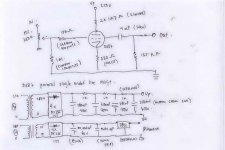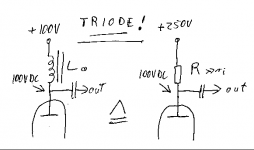GMuffley said:Unless money is very tight, you can do MUCH better than a Solen output cap.
I'd try it with AC filaments, lifted to about 25V.
Sheldon
costa23 said:I've build my 5687 line stage preamp. i attached the scheme below.
Please comment about this scheme...
...
Thanks a lot.
Hi, do you take the output from cathode, anode or grid?
http://www.diyaudio.com/forums/attachment.php?s=&postid=1579557&stamp=1218073742
costa23 said:...
The output is from anode...
...
Thanks,
do you need voltage gain?
If so how much?
Note the the anode output inverts the phase.
check out this site
http://www.diyparadise.com/simplepreamp.html
I built this design and added gas regulators to it. Look around the site and you will find the schematic and the power supply. When built as he designed it has ZERO noise. The chokes are an important part in the design and cost very little. I would eliminate the fancy caps and led and build as shown. When you are comfortable with it then dive into a CCS and see if there are any differences to be had.
I believe if you do a search a thread should turn up here.
http://www.diyparadise.com/simplepreamp.html
I built this design and added gas regulators to it. Look around the site and you will find the schematic and the power supply. When built as he designed it has ZERO noise. The chokes are an important part in the design and cost very little. I would eliminate the fancy caps and led and build as shown. When you are comfortable with it then dive into a CCS and see if there are any differences to be had.
I believe if you do a search a thread should turn up here.
costa23 said:Does anybody know how to make this scheme better ?
Better in what way? And to whom?
I know what i'd do. Get rid of all the nice and cosy carbon comps and Kiwame resistors. They help produce a pleasant but also very coloured sound. Put some Caddocks in place.
Replace the anode resistor with a choke and experience a really serious improvement.
Replace the diodes with mercury rectifiers or tv dampers. Obviously the entire PS will need redoing then.
Chokes are a very good idea, they bring a nice rich tone.
5687 tends to oscillate so make certain the grid is stoppered and the anode load is straight onto the pin.
I built a version with a CCS load and it sounds a little to detailed for my taste, still the 5687 is an excellent valve.
AC on the filament is fine, though if the 5687 starts oscillating it will tend to pick up hum from the filament. If you experience hum problems don't blame the filament - look for the instability !!
Shoog
5687 tends to oscillate so make certain the grid is stoppered and the anode load is straight onto the pin.
I built a version with a CCS load and it sounds a little to detailed for my taste, still the 5687 is an excellent valve.
AC on the filament is fine, though if the 5687 starts oscillating it will tend to pick up hum from the filament. If you experience hum problems don't blame the filament - look for the instability !!
Shoog
Shoog said:Chokes are a very good idea, they bring a nice rich tone.
I don't agree.
I don't like the distortions, phase shifts and limited bandwidth
caused by chokes.
oldeurope said:
I don't agree.
I don't like the distortions, phase shifts and limited bandwidth
caused by chokes.
Distortions? What about the effective doubling of output undistorted votage?
Limited bandwidth? I don't advocate using PS chokes as anode loads. Proper anode chokes have low capacitance and it's easy to achieve 50-70kHz bandwidth.
In practice your objections are non-issues.
#13
Hello analog_sa
E.g. Hysteresis distortions.
(An air coil has no hysteresis.)
??? See attachment
Yes of course, especially if you have high impedance stages.
Sure, a resistor has less capacitance than a coil and
 it doesn't change it's impedance with the frequency.
it doesn't change it's impedance with the frequency.
(You can get resistors that go from DC to UHF and higher.)
One coil, the output transformer, is definitely enough.
Kind regards,
Darius
Hello analog_sa
Originally #13 posted by analog_sa
Distortions? ...
E.g. Hysteresis distortions.
(An air coil has no hysteresis.)
Originally #13 posted by analog_sa
...
What about the effective doubling of output undistorted votage?
...
??? See attachment
Originally #13 posted by analog_sa
...
Limited bandwidth? I don't advocate using PS chokes as anode loads. Proper anode chokes have low capacitance and it's easy to achieve 50-70kHz bandwidth.
...
Yes of course, especially if you have high impedance stages.
Sure, a resistor has less capacitance than a coil and
 it doesn't change it's impedance with the frequency.
it doesn't change it's impedance with the frequency.(You can get resistors that go from DC to UHF and higher.)
One coil, the output transformer, is definitely enough.
Kind regards,
Darius
Attachments
Re: #13
Ok, i'll give you a clue: it's got to do with inductance, not dc operating points
oldeurope said:
??? See attachment
Ok, i'll give you a clue: it's got to do with inductance, not dc operating points
Re: Re: #13
I still don't know what you mean.
Please give me an example.
Kind regards,
Darius
analog_sa said:
Ok, i'll give you a clue: it's got to do with inductance, not dc operating points
I still don't know what you mean.
Please give me an example.
Kind regards,
Darius
Lemme take a stab.
With a choke, you can actually swing more voltage than is available with a resistor. If I have a 150V B+ serving a 6SN7, the triode can actually swing from 0 to 300V. Approximately, of course; the triode doesn't actually reach 0V, but the principle is there.
With a resistor, the triode can never swing more than 150V, because that's all that's available from B+.
Is this what you mean?
With a choke, you can actually swing more voltage than is available with a resistor. If I have a 150V B+ serving a 6SN7, the triode can actually swing from 0 to 300V. Approximately, of course; the triode doesn't actually reach 0V, but the principle is there.
With a resistor, the triode can never swing more than 150V, because that's all that's available from B+.
Is this what you mean?
not true ...
 This is not ok.
This is not ok.
You have to compare the stages under same conditiones i.e. same anode voltage.
See example in post #14 :
http://www.diyaudio.com/forums/attachment.php?s=&postid=1580725&stamp=1218205773
zigzagflux said:Lemme take a stab.
With a choke, you can actually swing more voltage than is available with a resistor.
Is this what you mean?
 This is not ok.
This is not ok. You have to compare the stages under same conditiones i.e. same anode voltage.
See example in post #14 :
http://www.diyaudio.com/forums/attachment.php?s=&postid=1580725&stamp=1218205773
oldeurope said:I don't like the distortions, phase shifts and limited bandwidth
caused by chokes.
My current line stage/buffer uses a Hammond 150H choke as a cathode follower load for a 6W6. Triode connected the midband distortion into >50k ohm is less than 0.003% at 1 vrms past 20 kHz, rising to ~0.05% at 20 Hz. Connected true pentode it drops below the ability of my M-Audio Firewire to measure reliably at 24 bit mid-band. It also passes a pretty nice 200 kHz square wave either connection, all easy flaws to live with in a $15 choke.
- Status
- This old topic is closed. If you want to reopen this topic, contact a moderator using the "Report Post" button.
- Home
- Amplifiers
- Tubes / Valves
- 5687 line stage

